Childeric I was the king of the Salian Franks from 457 until his death in 481/2 A.D., and the father of Clovis I, the man who would unite the Frankish tribes under his rulership and become the first of the Merovingian kings of France. Childeric established a capital at Tournai on lands he had received as a foederatus (a military ally who received money and lands in exchange for fighting for Rome) in what was then the province of Belgica Secunda.
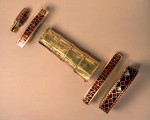 Clovis moved the capital to Paris and over time the location of his father’s tomb was lost. It was rediscovered on May 27th, 1653, by one Adrien Quinquin who was doing some work on the church of Saint-Brice when his shovel suddenly turned up a cache of gold coins. Further excavation revealed a tomb full of treasures, among them a throwing axe, a spear, a long sword called a spatha and a short scramasax with scabbard, both richly ornamented with gold and garnet cloisonné, a solid gold torc bracelet, part of an iron horseshoe with nails still in it, belt and shoe buckles and horse harness fittings also decorated in cloisonné gold and garnets, a leather purse containing more than a hundred gold and silver coins, the most recent bearing the image of the Byzantine Emperor Zeno (474-491 A.D.), a gold bull’s head with a solar disc on its forehead, a crystal ball and a gold signet ring.
Clovis moved the capital to Paris and over time the location of his father’s tomb was lost. It was rediscovered on May 27th, 1653, by one Adrien Quinquin who was doing some work on the church of Saint-Brice when his shovel suddenly turned up a cache of gold coins. Further excavation revealed a tomb full of treasures, among them a throwing axe, a spear, a long sword called a spatha and a short scramasax with scabbard, both richly ornamented with gold and garnet cloisonné, a solid gold torc bracelet, part of an iron horseshoe with nails still in it, belt and shoe buckles and horse harness fittings also decorated in cloisonné gold and garnets, a leather purse containing more than a hundred gold and silver coins, the most recent bearing the image of the Byzantine Emperor Zeno (474-491 A.D.), a gold bull’s head with a solar disc on its forehead, a crystal ball and a gold signet ring.
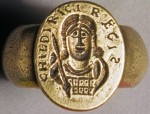 The signet ring was the proverbial smoking gun that identified the tomb as Childeric’s. It’s a heavy gold ring 27mm (one inch) in diameter (Childeric had some large fingers). On top is an oval bezel bearing the effigy of a beardless man with long hair parted in the center. He wears a paludamentum (a draped cloak fastened at one shoulder worn by Roman military leaders and emperors in statuary and on coinage) and holds a spear in his right hand. Around the head is the inscription CHILDERICI REGIS (Childeric King).
The signet ring was the proverbial smoking gun that identified the tomb as Childeric’s. It’s a heavy gold ring 27mm (one inch) in diameter (Childeric had some large fingers). On top is an oval bezel bearing the effigy of a beardless man with long hair parted in the center. He wears a paludamentum (a draped cloak fastened at one shoulder worn by Roman military leaders and emperors in statuary and on coinage) and holds a spear in his right hand. Around the head is the inscription CHILDERICI REGIS (Childeric King).
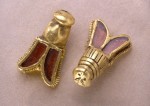 More than 300 golden bees with red glass wings were also found that are thought to have adorned Childeric’s ceremonial cloak. Centuries later, when Napoleon Bonaparte was about to be crowned Emperor of the French, he turned to the most ancient French monarch for iconography that would connect him to royal history while bypassing the still-loathed Bourbons and their fleur-de-lys. Napoleon adopted Childeric’s heraldry as his own. His coronation robe was embroidered with 300 gold bees and bees became the symbol of the new French Empire.
More than 300 golden bees with red glass wings were also found that are thought to have adorned Childeric’s ceremonial cloak. Centuries later, when Napoleon Bonaparte was about to be crowned Emperor of the French, he turned to the most ancient French monarch for iconography that would connect him to royal history while bypassing the still-loathed Bourbons and their fleur-de-lys. Napoleon adopted Childeric’s heraldry as his own. His coronation robe was embroidered with 300 gold bees and bees became the symbol of the new French Empire.
 When Childeric’s treasure was discovered, Tournai was part of the Spanish Netherlands, governed by Archduke Leopold Wilhelm of Austria, younger brother of Holy Roman Emperor Ferdinand III. The bulk of Childeric’s grave goods (there was much pilfering, apparently, during the dig) went to the Archduke who had the great good sense to order his physician Jean-Jacques Chifflet to document every piece thoroughly. Chifflet’s meticulous study, complete with extremely detailed engravings of the artifacts, was published in 1655 as Anastasis Childerici I. Francorvm Regis, sive Thesavrvs Sepvlchralis Tornaci Neruiorum (The Resurrection of Childeric the First, King of the Franks, or the Funerary Treasure of Tournai of the Nervians). Dependant on ancient sources and comparisons with other artifacts, Chifflet made some errors and misidentified some of the pieces, but his careful recording of every object is today considered the first scientific archaeological publication before there was such a thing as archaeological science.
When Childeric’s treasure was discovered, Tournai was part of the Spanish Netherlands, governed by Archduke Leopold Wilhelm of Austria, younger brother of Holy Roman Emperor Ferdinand III. The bulk of Childeric’s grave goods (there was much pilfering, apparently, during the dig) went to the Archduke who had the great good sense to order his physician Jean-Jacques Chifflet to document every piece thoroughly. Chifflet’s meticulous study, complete with extremely detailed engravings of the artifacts, was published in 1655 as Anastasis Childerici I. Francorvm Regis, sive Thesavrvs Sepvlchralis Tornaci Neruiorum (The Resurrection of Childeric the First, King of the Franks, or the Funerary Treasure of Tournai of the Nervians). Dependant on ancient sources and comparisons with other artifacts, Chifflet made some errors and misidentified some of the pieces, but his careful recording of every object is today considered the first scientific archaeological publication before there was such a thing as archaeological science.
 Archduke Leopold brought Childeric’s treasure with him to Vienna when he left the Spanish Netherlands in 1656. Upon his death in 1662, he bequeathed his extensive gallery of art and artifacts, including Childeric’s grave goods, to his nephew, Holy Roman Emperor Leopold I. In 1665, Leopold I gifted the Childeric treasure to King Louis XIV in gratitude for his military aid against the Ottoman Empire in Hungary the year before. Louis, reportedly unimpressed by the 5th century version of luxury goods, had them stored in his Cabinet of Medals in the Louvre palace. After the French Revolution, Childeric’s treasure became part of the Cabinet of Medals of the Imperial Library, later the Royal Library, now the National Library.
Archduke Leopold brought Childeric’s treasure with him to Vienna when he left the Spanish Netherlands in 1656. Upon his death in 1662, he bequeathed his extensive gallery of art and artifacts, including Childeric’s grave goods, to his nephew, Holy Roman Emperor Leopold I. In 1665, Leopold I gifted the Childeric treasure to King Louis XIV in gratitude for his military aid against the Ottoman Empire in Hungary the year before. Louis, reportedly unimpressed by the 5th century version of luxury goods, had them stored in his Cabinet of Medals in the Louvre palace. After the French Revolution, Childeric’s treasure became part of the Cabinet of Medals of the Imperial Library, later the Royal Library, now the National Library.
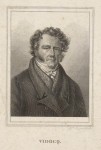 During the night of November 5th 1831, thieves broke into the Cabinet of Medals of the Bibliothèque Nationale de France and stole more than 2,000 gold objects for a total weight of 80 kilos, including all of Childeric’s treasure. Accounts of what happened afterwards differ because many of the records were destroyed during the Paris Commune of 1871. Either a couple of suspects were arrested within a few days of the theft and refused to talk leaving the police to search for the treasures for 8 months, or the police searched 8 months before finding the culprits and what was left of the treasure. Whichever way it went, the theft was a huge scandal and the police were under great pressure to come up with results. They even enlisted the aid of the legendary Eugène-François Vidocq, head of the Sûreté, Paris’ first-of-its-kind plainclothes detective bureau that he had founded in 1812. Vidocq had quit in 1827 but was reappointed head of the Sûreté in early 1832 and he and his team were on the Childeric case.
During the night of November 5th 1831, thieves broke into the Cabinet of Medals of the Bibliothèque Nationale de France and stole more than 2,000 gold objects for a total weight of 80 kilos, including all of Childeric’s treasure. Accounts of what happened afterwards differ because many of the records were destroyed during the Paris Commune of 1871. Either a couple of suspects were arrested within a few days of the theft and refused to talk leaving the police to search for the treasures for 8 months, or the police searched 8 months before finding the culprits and what was left of the treasure. Whichever way it went, the theft was a huge scandal and the police were under great pressure to come up with results. They even enlisted the aid of the legendary Eugène-François Vidocq, head of the Sûreté, Paris’ first-of-its-kind plainclothes detective bureau that he had founded in 1812. Vidocq had quit in 1827 but was reappointed head of the Sûreté in early 1832 and he and his team were on the Childeric case.
(They were on a lot of other cases at the same time, like ruthlessly suppressing the June Rebellion in Paris after the death from cholera of General Jean Maximilien Lamarque. Victor Hugo’s Les Misérables was set against the backdrop of this rebellion and Vidocq was the inspiration for Javert. He was the inspiration for Valjean as well, believe it or not, because he had been a criminal in his youth, done hard labour in the galleys of Brest, escaped, been caught, escaped again, got caught again, did more time before finally turning his particular set of skills to the aid of law enforcement by becoming an informant. He parlayed that into undercover detective work. Under him, the Sûreté was staffed by convicts operating under the it-takes-one-to-know-one premise. It was highly effective. Crime rates in Paris dropped 40% after the Sûreté began doing its thing. Vidocq was also the inspiration for the character of C. Auguste Dupin in Edgar Allen Poe’s The Murders in the Rue Morgue, the first detective story.)
![]() Anyway, eight months after the theft, the police busted a gang of thieves and found 20 ingots of gold in their hideout. Upon interrogation the thieves admitted they had melted down the pure gold objects into ingots while those with inlaid stones or that were harder to melt down for whatever reason were put in sacs of leather and immersed in the Seine either at the Pont Marie or the Pont de la Tournelle. (The bridges are in the same spot on the Seine. The Pont Marie connects the Île Saint-Louis to the Right Bank; the Pont de la Tournelle is its mirror, connecting the island to the Left Bank.) When the police dragged the river, they found eight bags holding around 1,500 pieces of the 2,000 stolen, 75 of the 80 kilos. Added to the ingot weight, the recovered objects were determined to be the entirety of the burgled treasure and the case was closed. In January of 1833, three of the thieves were convicted of the crime. One was sentenced to 40 years in prison, one to 20 years, one to 10.
Anyway, eight months after the theft, the police busted a gang of thieves and found 20 ingots of gold in their hideout. Upon interrogation the thieves admitted they had melted down the pure gold objects into ingots while those with inlaid stones or that were harder to melt down for whatever reason were put in sacs of leather and immersed in the Seine either at the Pont Marie or the Pont de la Tournelle. (The bridges are in the same spot on the Seine. The Pont Marie connects the Île Saint-Louis to the Right Bank; the Pont de la Tournelle is its mirror, connecting the island to the Left Bank.) When the police dragged the river, they found eight bags holding around 1,500 pieces of the 2,000 stolen, 75 of the 80 kilos. Added to the ingot weight, the recovered objects were determined to be the entirety of the burgled treasure and the case was closed. In January of 1833, three of the thieves were convicted of the crime. One was sentenced to 40 years in prison, one to 20 years, one to 10.
 Devastatingly, Childeric’s treasure was almost entirely lost. Authorities recovered two coins, two bees and the gold and garnet cloisonné fittings from Childeric’s sword and scramasax. The signet ring was gone, only surviving as reproductions made by the Habsburgs and in imprints taken of the seal. Chifflet’s recorded data and illustrations are virtually all that remains of this historic treasure
Devastatingly, Childeric’s treasure was almost entirely lost. Authorities recovered two coins, two bees and the gold and garnet cloisonné fittings from Childeric’s sword and scramasax. The signet ring was gone, only surviving as reproductions made by the Habsburgs and in imprints taken of the seal. Chifflet’s recorded data and illustrations are virtually all that remains of this historic treasure
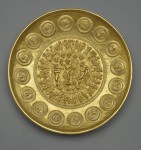 One of the recovered artifacts from the 1831 theft at the Bibliothèque Nationale is actually in the United States right now. The Rennes patera, an early 3rd century Roman shallow libation bowl made of no less than three pounds of very pure solid 23-carat gold, somehow survived being melted down in the thieves’ initial orgy of ingot production. It was loaned by National Library to the Getty Villa in Malibu for the Ancient Luxury and the Roman Silver Treasure from Berthouville exhibition and will be in California through August 17th before returning to Paris.
One of the recovered artifacts from the 1831 theft at the Bibliothèque Nationale is actually in the United States right now. The Rennes patera, an early 3rd century Roman shallow libation bowl made of no less than three pounds of very pure solid 23-carat gold, somehow survived being melted down in the thieves’ initial orgy of ingot production. It was loaned by National Library to the Getty Villa in Malibu for the Ancient Luxury and the Roman Silver Treasure from Berthouville exhibition and will be in California through August 17th before returning to Paris.
My eyes just bugged when I read that the idiot thieves had MELTED THE GOLD DOWN. Wow. The colossal stupidity and the great loss that the stupidity entailed. Man. That’s a head shaker for sure. “OK, let’s not only steal priceless, irreplaceable treasures, let’s melt some of it down and throw some into the river.”
(I also found it interesting, and a bit amusing, that Vidocq was the inspiration for both the villain and the hero of Les Miserables.)
And why would they start by melting down all of Childeric’s fiddly belt buckles and buttons and bees but stuff a plate that’s three full pounds of pure gold in the Seine for later? It makes no sense at all. Either the thieves were so erratic and irrational it’s a wonder how they ever pulled off the heist in the first place, or maybe, just maybe, there’s a ninth bag still in the Seine. I console myself with the fantasy that one day some mudlark will make the find of 20 lifetimes.
(I did as well. Javert and Valjean are literally aspects of the same character. One is what happens when you take the left fork in the road, the other when you take the right.)
Too bad the Habsburgs didn’t keep it since virtually every cultural, archeological and artistic work collected by them over 600 years is to be seen in one of the many museums they founded and sponsored. As others wished to emulate the emperor, they in turn founded collections (like the Lichtenstein Museum) in Vienna as well. And cataloging as well as copying a few pieces, was also a useful service to posterity. Of course a number of Habsburgs today work in major museums like the Met…
Vienna didn’t suffer heavy bombing until the end of the war, too. The Habsburg cultural patrimony has had the advantage of location as well as the committment of generations of powerful rulers.
I suppose archaeological treasures are necessarily at higher risk in museums than safely tucked up under the earth. It might be wise to diversify the number of places in which some of them are held, but I’m sure there would have been protests if the collection of “bees” had been split up.
Today there would be but not back then, I don’t think. Most of the coins in the Rennes treasure were used as trading stock and nobody thought anything of it.
A fascinating read, with a heat breaking outcome. Such a terrible shame.
It is. So much was lost of French monarchical history in the Revolution, for this unbelievable treasure to have survived that only to be destroyed by bumbling thieves is just heartbreaking.
If there are a few extra bags of loot still missing in the river, the bags would have rotted away by now and the treasures scattered and sunken into the ooze. 😥
But even then there is still hope that maybe a few items might eventually see the light of day again.
Mostly when we find old treasure it is historically significant but not necessarily beautiful, to our modern eyes at least. But the cloisonné gold and garnets fittings and bracelet are utterly gorgeous. Even the golden bees with red glass wings were cleverly designed.
That type of throwing Axe was referred to in its latinized form as ‘Francisca’. Moreover, the ‘Franks’ influenced what is ‘Belgium’ today (Belgica), parts of Germany and the Netherlands as during the expansion what is nowadays referred to as ‘France’. An illustration might be Austrasia in 481 and the recent distribution of Franconian languages and dialects.
Great fun – what a tragedy!
How fun would it be to make a discovery like she did in 1653. Her research definitely paid off.
Such a shame that it was all destroyed, just goes to show you that nothing lasts forever.
I wonder if there’s a curious story behind the signet’s inscription – the ‘CHILDERIC’ part is all lined up and tidy but then you get to ‘REGIS’ and it looks like the goldsmith had a drunken first-day-ever apprentice setting up the lettering.
Or maybe the ring was demanded before it was finished and the smith was annoyed and did the remainder of the letters carelessly and in haste.
Adding another voice to the sadness and disappointment over the loss of such interesting and storied articles. Grateful for the treasure of the marked accounting of the artifacts as they were found.
…and now I want to make some toggle buttons after the fashion of Childeric Bees.
The theft of the gold treasures was not long after the French Revolution and, as I would imagine, anything that was of royal reminder was probably not held dear to the people. The European economy was a disaster with poverty was a way of life for most citizens. Under those circumstances, I imagine most would do whatever it took to survive.
On the other hand, it seems that these thieves were simply thieves.
Very interesting! They look like horseflies. Could they have been tied to the horses tack to swing and actually keep the horseflys away? Horses bolting from flys is an actual problem I think.
Yes, there actually is a theory that the bees had originally been attached to horse harnesses.
If 1500 of 2000 pieces stolen were recovered, how is the treasure “almost entirely lost”?
One more thing: Did any of the gold coins found have dates along with the visage of Zeno? As I understand it, Zeno reigned from 474 to 491. Some have suggested that the coins’ dating means Childeric lived until 491, instead of 481/2.
If true, that would really mess up the conventional dates for the battles of Soisson and Tolbiac (I), not to mention a few other things.
Just one more reason to moor the old canal boat and get the metal detector out ,, just fishing Inspector just fishing :yes:
Given the history of ‘Thief Catchers General’ in London i.e. the biggest thief of them all, who merely regulated the thefts …. it wouldn’t surprise me that the Villain/Hero of this piece was also the mastermind behind the theft…. and its partial recovery…..
However, Given it was only Merovingian treasure that was lost also begs the question, “Was there a Roman Catholic/ Patrician interest in losing items that tied the Merovingian dynasty to the attempted Constantinopolitan Arian supremacy (as in Non-Trinitarianism) which some people think was behind the success of the Merovingian Celto-restitution, which hereditary practices shared lands and belongings equally between wives and offspring …..
.. a concept that would undoubtedly have had great appeal in The Republic of France at the time…… Just think, if all these Super Rich Divine-Righters had to give back all that they have taken within the blessing of the Roman Papal hereditary establishment… what would life be like ? !
….. we probably wouldn’t now be stuck with a ‘British Tory Party’ doing their best to start another European War….to benefit their Offshore banking monopoly … and etc etc
Delving into the depths of my family history. It’s so fascinating!!!